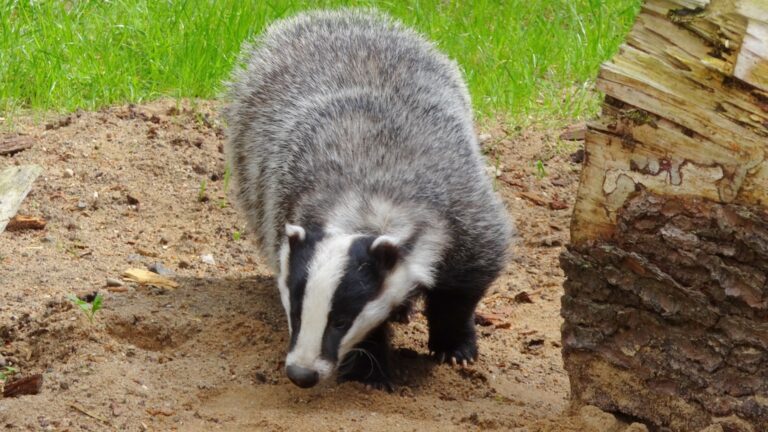Badgers are virtually synonymous with tenacity, but are they dangerous? Most folks don’t know too much about badgers.
These are interesting animals that are noteworthy for their intricate social and family units that form in the wild, and they’re also important game and fur animals that are harvested for their hair and for their meat.

Chances are you won’t encounter a badger in the wild unless you head out into deep country, because they tend to keep to themselves.
But should you be worried if you run into one? Are badgers dangerous?
No, not really. Badgers as a rule would rather avoid contact with people than fight, but if they are cornered, grabbed or if you are threatening their young they are capable of putting up quite a fight, and badgers do have a powerful bite.
Most North American badgers are not particularly big, but don’t make the mistake of thinking that they won’t fight if they have to.
Badgers will do everything they can to get away from you if you come too close, but if you corner them or threaten their family unit, they may attack with ferocity out of all proportion with their size.
Even so, badgers are not typically considered to be dangerous to people. Keep reading, and I’ll tell you everything you need to know about these interesting animals.
Badger Overview, Temperament and Habitat
Badgers really are one of the most interesting animals on Earth. Not just because they have been historically important for the products they can provide when trapped or hunted.
It’s because of the surprisingly intricate, nuanced connections that badgers make among their own kind, sometimes even with other species!
Badger species can be found all over the world, predominantly in North America, the United Kingdom, and throughout much of Europe though some can be found all across Asia and much of Africa.
Badgers belong to the Mustelidae family, making them relatives to wolverines, weasels, ferrets and otters, and they look quite similar to these animals though they are notable for having a much larger and stockier body, a shorter neck and large, prominent front claws that are used for digging.
In the wild, badgers exhibit a tendency towards living in family units, with extended families generally getting along peaceably inside a larger shared territory. These larger social units are referred to as clans.
Some badgers, though, individually show a marked tendency towards being loners, though they may or may not temporarily rejoin a family unit for various reasons.
In any case, all badgers, whether solitary or in a family unit, can rapidly excavate large, deep and intricate subterranean burrows called setts where they will live and sometimes store food.
Badgers are remarkably good diggers, among the fastest found in nature, and they use these skills to track down similarly subterranean food in the form of various rodents, reptiles and other underground critters.
Near areas of human habitation, badgers are also marked predators of small livestock, particularly poultry and eggs, and sometimes vulnerable individuals of smaller species like goats and sheep.
But something that is even more remarkable is the fact that badgers, in the wild, can form a sort of pact or you might even say friendship with other species, usually coyotes and wolves.
These interactions have been caught on video multiple times, so if you see a badger following a coyote or wolf, they might be working together!
Whether you find a badger with its family or alone, you can generally depend on them retreating from any contact with a human being unless they feel cornered or feel like their young is threatened.
Do Badgers Protect Their Territory?
Badgers will typically protect their territory from certain animals and from other badgers that aren’t part of the clan unit. Individual badgers might also have beef with individuals of other clans, and this can lead to scuffles.
However, it’s rare for a badger to act territorial towards a human or any other large animal in their territory as long as they aren’t getting too close to their burrow.
That might provoke a defensive response to run off the intruder!
Do Badgers Act Aggressively Toward Each Other?
Yes, sometimes. Territorial pressures as described above can lead to fights between badgers, and mating season pressures can cause horny males to turn downright belligerent towards other males.
But aside from these instances as long as there is peace between neighboring clans and lone individuals badgers tend to get along.
Do Badgers Threaten People?
Badgers generally do not threaten people except when they feel cornered, are restrained directly or if they feel like they must protect their young. In these cases, a badger will usually go on the attack directly.
It is encounters like this that have given rise to the badger’s well-deserved reputation for tenacity and ferocity, however! So stay alert!
Have There Been Recorded Badger Attacks on People?
Yes, indeed there have been. There are quite a few well-known historical instances of badger attacks on humans.
Generally, though, this is a direct result of human impingement on their immediate territory or due to a botched attempt to trap or kill them. Badgers greatly prefer to run and hide from humans and other larger animals rather than fight if they are able.
Even so, compared to other wild animals and wild mammals in particular badger attacks are rare.

What Will Trigger a Badger Attack on a Person?
Coming too close to a badger’s burrow, pursuing it when it is trying to get away, coming too close to a badger with young or trying to trap, restrain or handle a badger will definitely provoke an attack.
Just How Strong is a Badger?
Badgers are actually quite strong, much stronger than you would think for an animal that usually is no bigger than a medium-sized dog.
Like most animals in their category, badgers have very strong jaws with great flexibility, and also impressive stamina that they use to dig quickly and for a long time.
A badger bite is a serious medical event, and can inflict lasting injuries, so don’t underestimate them.
Can Badgers Bite?
Yes, absolutely: badgers can and will bite. The bite of a badger is quite severe, and their immense jaw strength and sharp, stout teeth means they can easily inflict significant puncture wounds or even break bones.
Worse yet, badgers have a tendency to bite and lock on as they thrashed to inflict even more damage, so it isn’t out of the question they could very literally bite a chunk out of you.
What Does a Badger Attack Look Like?
When badgers attack they go all out. They will charge immediately and try to bite, but they will also swipe with their claws. But it is the bite you have to worry about as discussed above.
A badger that is provoked to violence might chase you for some distance, so be prepared for a lengthy retreat if you don’t want to engage the badger.
How Do You Respond to a Badger Attack?
The very best thing you can do to respond to a badger attack is simply to get away. If you’re able, run away as quickly as you can.
Badgers are surprisingly quick and nimble, but they have very short limbs so you should be able to outmaneuver them in most types of terrain.
If you cannot outrun the badger or if that just isn’t an option, defend yourself using whatever you have at hand and prioritize using any tool that can keep the badger from reaching you or put it down at a distance. Do everything that you can to avoid being bitten.
However, use great care if you’re going to try to restrain the badger when you come into contact with it…
They are surprisingly wiry, agile animals, and they have a tendency to twist inside their loose-fitting skin to bite from unexpected angles, so don’t assume you are safe just because you have a hold of its neck.
Can a Badger Eat Someone?!
Not really. Unlike a bear or a mountain lion, a badger is not going to attack you with the intention of making dinner out of you. But, badgers are carnivores, or at least carnivorous, and that means they eat meat.
Badgers have also been known to scavenge meat from fresh and relatively intact corpses, so if for whatever reason something were to happen to you and badger territory it is possible that badgers might nibble on your body.
To be perfectly clear, a badger is not going to try to kill and eat you.
Can People Catch Diseases from Badgers?
Badgers do carry a few diseases of note that you might want to worry about, although badgers are very low on the list of concerns when it comes to animal-to-human transmission.
The most significant disease that badgers are known to carry is bovine tuberculosis, more of a concern for anyone who owns cattle or other livestock.
It is possible for badgers to transmit this disease to cows through the environment, and then cows can transmit the disease to people through milk, although pasteurization typically takes care of it.
The post Badgers: Are They Dangerous? appeared first on Modern Survival Online.
via Modern Survival Online https://ift.tt/mRuWhYe
No comments:
Post a Comment